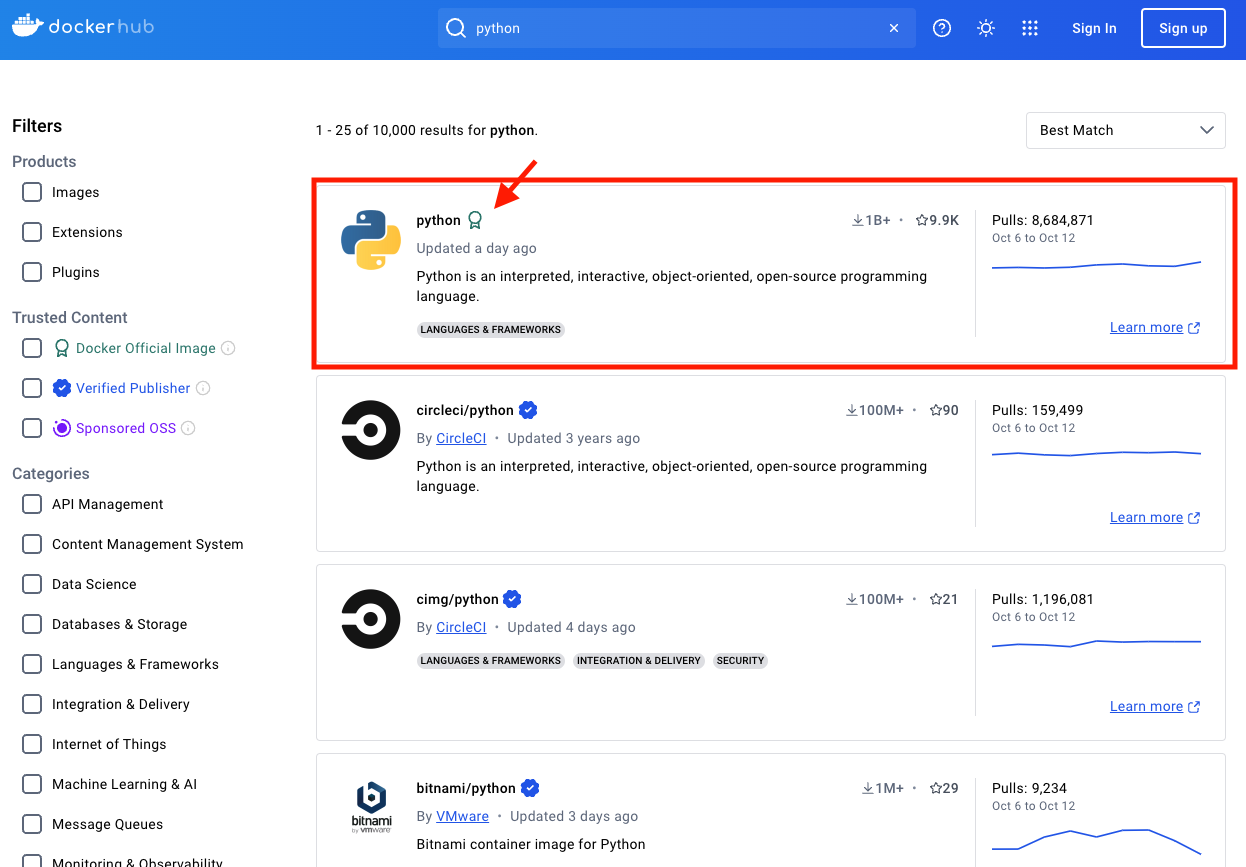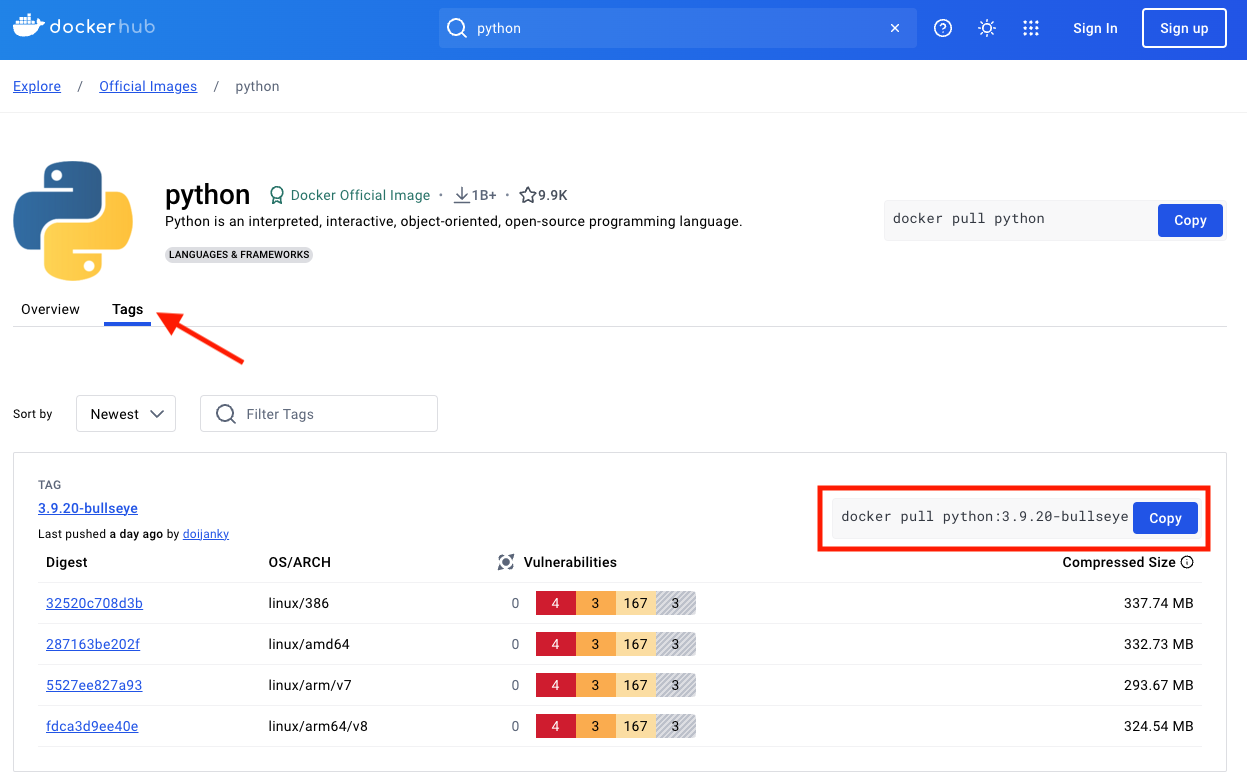Pulling Containers
Pulling pre-built container images is often the easiest and quickest way to run your desired software environment. In this tutorial, we will pull a container from Docker Hub. DockerHub is a cloud-based registry that provides access to a large repository of pre-built container images. Other container registries include NVIDIA NGC, Biocontainers, Sylabs.io, and Quay.io. For more information on accessible container registries, check out the containers documentation page HERE.
Set Up
To start, log into Hyak and navigate away from your home directory to a directory where you have access to storage. For this tutorial, we will work these exercises using a directory in /gscratch/scrubbed/. You may choose a working directory under another path on the filesystem, but we recommend not performing these exercises in your Home directory due to storage limitations. Learn more about storage on Hyak HERE.
# Remember to replace the word "UWNetID" in the command below with your UW NetID.
ssh UWNetID@klone.hyak.uw.edu
Navigate to /gscratch/scrubbed/
cd /gscratch/scrubbed
If you have not already, make a directory with your UW NetID.
# Remember to replace the word "UWNetID" in the command below with your UW NetID.
mkdir UWNetID
cd UWNetID
Next, ensure that the tutorial materials are copied to your working directory. In this tutorial, your copy of the basics directory will be our working directory:
cp -r /sw/hyak101/basics .
cd basics
The program klone uses for containers is Apptainer. When pulling a Docker container, Apptainer is able to convert the Docker container into an Apptainer container. However, to use Apptainer, you must be on a compute node:
salloc --partition=ckpt-all --cpus-per-task=1 --mem=10G --time=2:00:00
Remember to use hyakalloc to see all of your available resources. If you are a demo account user, please use the ckpt-all partition as shown above
Pulling a Container to Hyak from Docker Hub
For this exercise, we will pull a Python container from Docker Hub. Follow this link to open Docker Hub and search for Python. Choose the first search result with the green badge symbol next to it. This green symbol indicates that it is an official docker image.

Next, click on the "Tags" tab next to the "Overview" tab. Notice how you can search for previous versions of Python here. In this tutorial, we will download the most recent version of Python (as of Fall 2024), which is installed in a container running Ubuntu's slim-bullseye release. Copy the code from the code box for the 3.9.20-bullseye image and paste it into your terminal.

Omit docker pull and replace it with apptainer pull docker:// so Apptainer pulls the container image from Docker Hub and converts it into an Apptainer container. Run this code to pull and build the container.
apptainer pull docker://python:3.9.20-slim-bullseye
The build should last 30 seconds to 1 minute. During the pull and build, you will see messages from Apptainer on the progress of the command.
INFO: Converting OCI blobs to SIF format
INFO: Starting build...
Copying blob 51915174edd6 done |
Copying blob 6dce3b49cfe6 done |
Copying blob 6baa3c816245 done |
Copying blob b1a235768000 done |
Copying config 577d271f21 done |
Writing manifest to image destination
2024/10/20 19:33:02 info unpack layer: sha256:6dce3b49cfe6dc4b4e0198412bb0578215c86dae41303c47438639853bcba562
2024/10/20 19:33:03 info unpack layer: sha256:6baa3c8162456d475e4457e9618f8675a68275ab908ce7d7b387be1383fab464
2024/10/20 19:33:03 info unpack layer: sha256:b1a235768000dab9a30d44317a02455337c578675503eda9c991f7aef041b6b6
2024/10/20 19:33:04 info unpack layer: sha256:51915174edd6bffd3e0d77786e26ff610a2864d5277374a84cfa7e43a297723d
INFO: Creating SIF file...
Once that is complete, check to see if it was successfully built. The container will have a file extension .sif.
ls
python_3.9.20-slim-bullseye.sif
When building a container, you may encounter the following error:

If you run into a Disk Quota Exceeded error when building the container, it is likely due to exceeding the storage limit in your home directory where the Apptainer cache is located by default. Because your home directory has a 10GB storage limit, the following commands may be useful to monitor your storage usage. To assess your storage in your home directory, use the following command:
du -h --max-depth 1
If you find your storage exceeding the 10GB quota, you will need to eliminate storage. It can be helpful to clear the Apptainer cache with the following:
apptainer cache clean
Default Apptainer Cache
You can now start up a job on a compute node with salloc if you have not already.
When you start a job on a compute node, the internal storage of that node
is available to be used for temporary read/write operations with the jobs.
This makes it a great place for the apptainer cache and the physical architecture of our filesystem doesn't interfere with this.
You can configure Apptainer to store its cache in a directory located on the local storage of the compute node with:
export APPTAINER_CACHEDIR=/scr
# or
export APPTAINER_CACHEDIR=/tmp
You can now proceed with building your container:
apptainer build container-image.sif container-recipe.def
You are now able to open a shell inside the container where you can run Python:
apptainer shell python_3.9.20-slim-bullseye.sif
The command prompt will change and now start with Apptainer>. This is how you know that you are now inside the Apptainer container. Input python into the terminal to open the container's Python shell:
Apptainer>python
Python 3.9.20 (main, Oct 19 2024, 01:00:05)
[GCC 10.2.1 20210110] on linux
Type "help", "copyright", "credits" or "license" for more information.
>>>
>>> should appear on the command prompt, indicating that you are now able to use Python interactively. To exit Python, use Ctrl+D.
To exit the container write exit
exit
The above tutorial is useful if you want to use the most recent version of Python. However, there is a native version of Python installed on Hyak. Check what version of Python this is with:
python --version
You can check the version of Python in the container with the following command:
apptainer exec python_3.9.20-slim-bullseye.sif python --version
apptainer exec rather than apptainer shell sends a command to be executed inside the container, rather than first opening a shell into the container.
Binding the Filesystem
Recall that Apptainer containers are by default read-only. This means that under default parameters you cannot store files within the container and the container is isolated so that it cannot access any files from outside the container. To demonstrate this, try to execute ls from within the container, and you will see none of your files and directories on Hyak will appear.
Open a shell into the container once more
apptainer shell python_3.9.20-slim-bullseye.sif
Try ls to list the directory.
ls
This isn't very practical. We will usually have more files outside of the container upon which we want to execute commands. To make the Hyak filesystem accessible to the container, you must bind your filesystem to your container. In this section, we will bind the Hyak filesystem and run a simple Python script in the container. If you have not already, exit Apptainer with exit. Using the nano text editor, let's create our Python script:
nano pi.py
# Example Python script imports the Math library and prints the number pi.
import math
print("Executing inside the container!")
print("Pi=",math.pi)
# Use `Ctrl+x` to exit the text editor.
Try to run the pi.py script without binding the filesystem.
apptainer exec python_3.9.20-slim-bullseye.sif python pi.py
/usr/local/bin/python: can't open file '/gscratch/scrubbed/finchkn/basics/pi.py': [Errno 2] No such file or directory
To access the pi.py script and execute it, the file system must be bound to the container. To bind the filesystem to the container AND run pi.py, use the following command:
apptainer exec --bind /gscratch/ python_3.9.20-slim-bullseye.sif python pi.py
Executing inside the container!
Pi= 3.141592653589793
You can also use apptainer shell to open a shell into the container and bind the filesystem so that the files are accessible and visible with ls.
apptainer shell --bind /gscratch/ python_3.9.20-slim-bullseye.sif
Now with ls you can list the contents of your working directory.
Apptainer> ls
Now you can now run pi.py inside the shell:
Apptainer>python pi.py
In the next section, we'll learn how to build custom containers.